Research Report: Theory of Constraints in Grocery Retail Supply Chain
VerifiedAdded on 2023/01/13
|13
|3338
|81
Report
AI Summary
This report examines the application of the Theory of Constraints (TOC) in managing supply chain risks within the grocery retail industry. The study begins with an introduction to supply chain management and the risks involved, such as government regulations and cost increases, highlighting the importance of TOC in mitigating these risks. Section 1 explains the key concepts of TOC, emphasizing its focus on identifying and addressing constraints to improve efficiency and profitability. The report then provides an overview of the contemporary context of the grocery retail sector, emphasizing its significance in the modern market. Section 3 outlines the research plan, including the objectives to explore TOC's role, identify supply chain risks, and analyze TOC's impact on risk management. The report details the quantitative research approach using questionnaires for primary data collection, with a sample size of 60 managers. The research aims to gather insights into how TOC can enhance supply chain management within grocery retail.
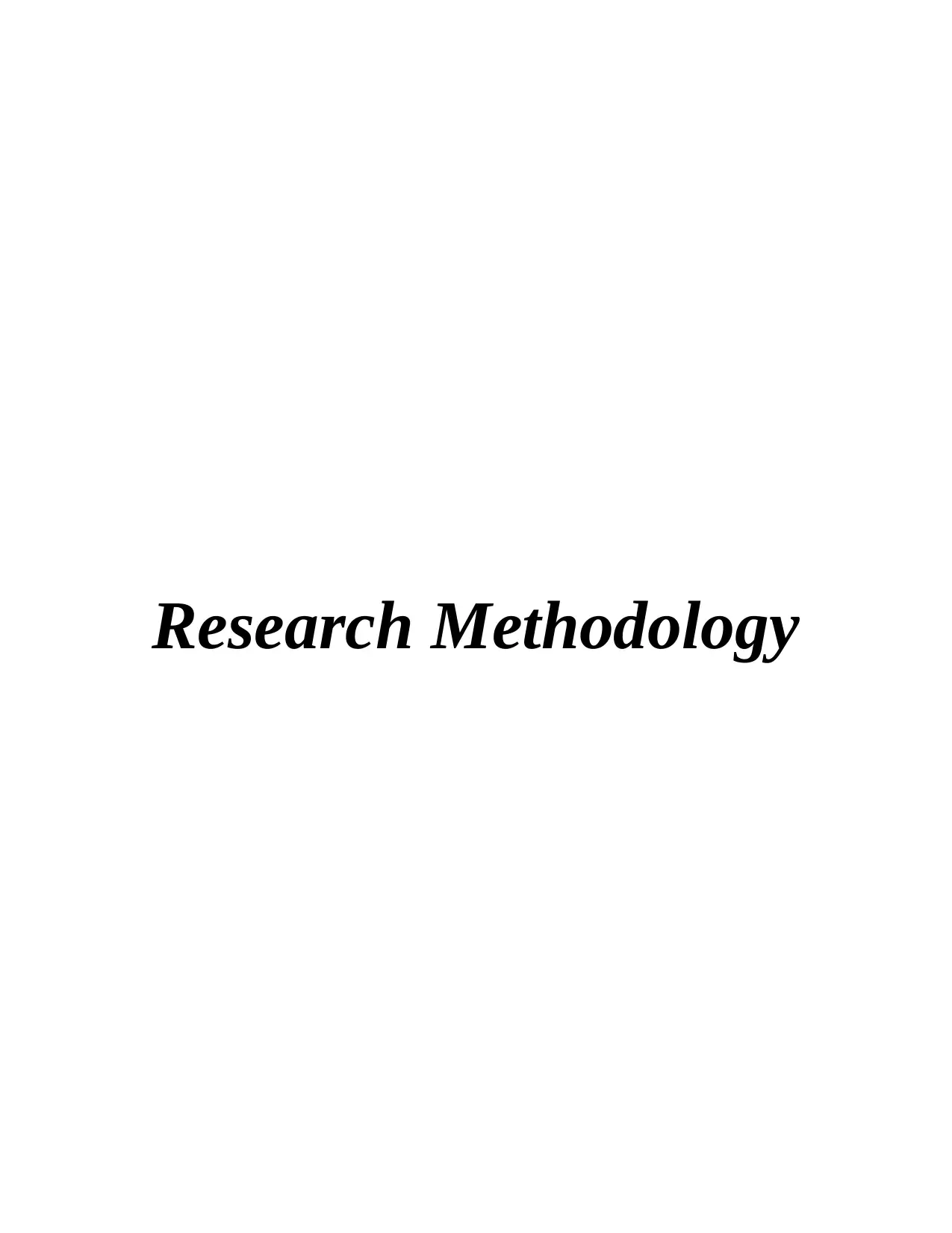
Research Methodology
Paraphrase This Document
Need a fresh take? Get an instant paraphrase of this document with our AI Paraphraser
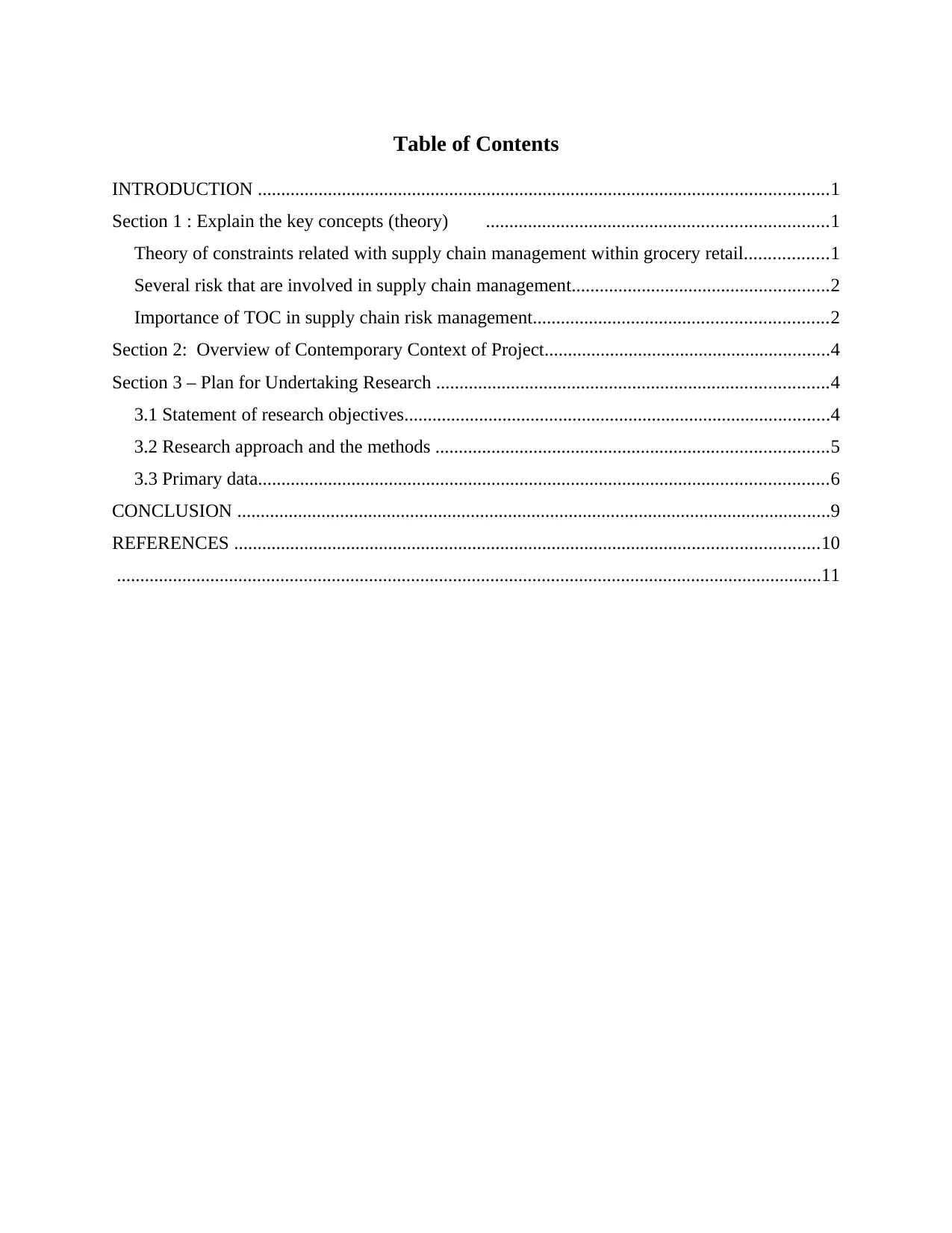
Table of Contents
INTRODUCTION ..........................................................................................................................1
Section 1 : Explain the key concepts (theory) .........................................................................1
Theory of constraints related with supply chain management within grocery retail..................1
Several risk that are involved in supply chain management.......................................................2
Importance of TOC in supply chain risk management...............................................................2
Section 2: Overview of Contemporary Context of Project.............................................................4
Section 3 – Plan for Undertaking Research ....................................................................................4
3.1 Statement of research objectives...........................................................................................4
3.2 Research approach and the methods ....................................................................................5
3.3 Primary data..........................................................................................................................6
CONCLUSION ...............................................................................................................................9
REFERENCES .............................................................................................................................10
.......................................................................................................................................................11
INTRODUCTION ..........................................................................................................................1
Section 1 : Explain the key concepts (theory) .........................................................................1
Theory of constraints related with supply chain management within grocery retail..................1
Several risk that are involved in supply chain management.......................................................2
Importance of TOC in supply chain risk management...............................................................2
Section 2: Overview of Contemporary Context of Project.............................................................4
Section 3 – Plan for Undertaking Research ....................................................................................4
3.1 Statement of research objectives...........................................................................................4
3.2 Research approach and the methods ....................................................................................5
3.3 Primary data..........................................................................................................................6
CONCLUSION ...............................................................................................................................9
REFERENCES .............................................................................................................................10
.......................................................................................................................................................11

⊘ This is a preview!⊘
Do you want full access?
Subscribe today to unlock all pages.

Trusted by 1+ million students worldwide
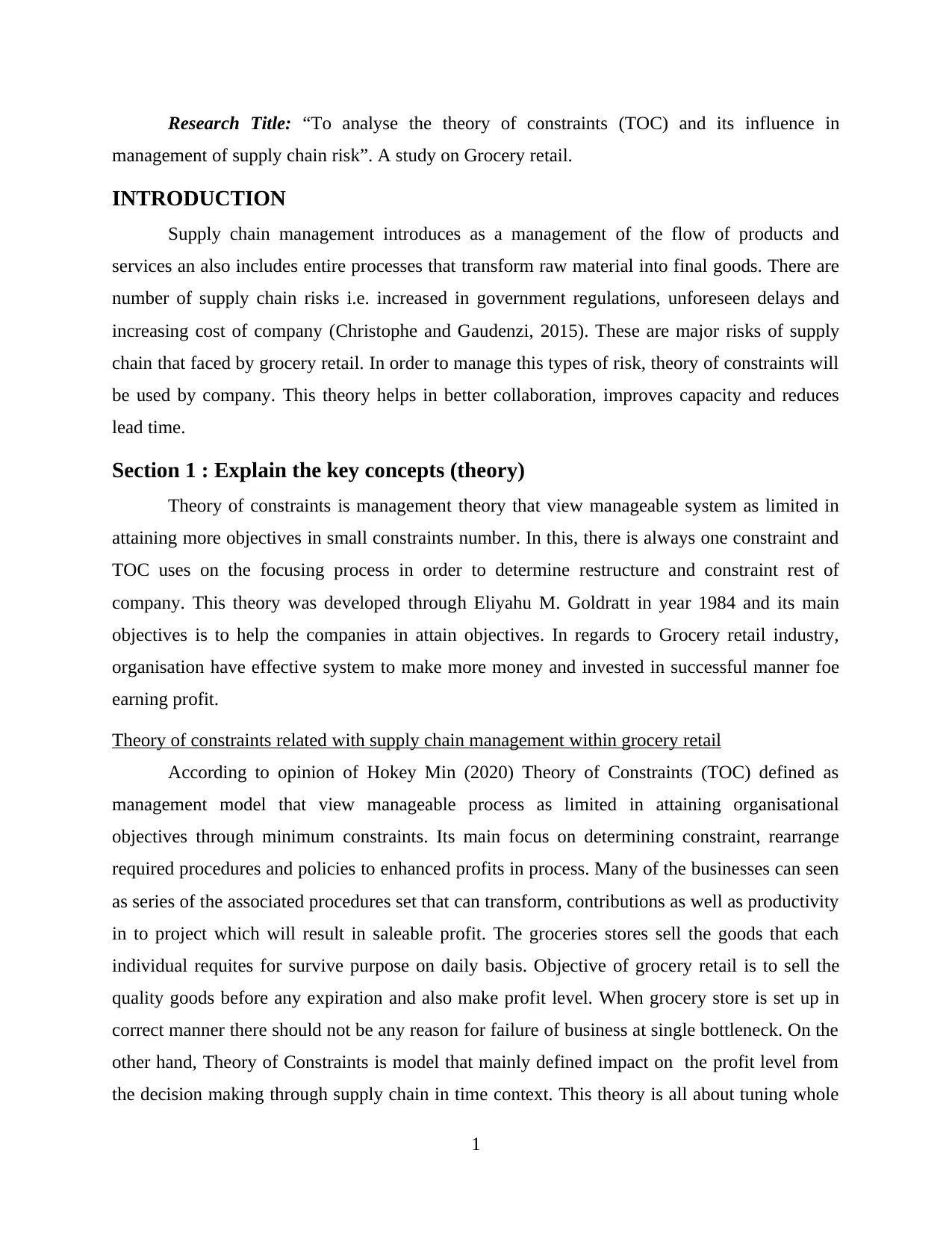
Research Title: “To analyse the theory of constraints (TOC) and its influence in
management of supply chain risk”. A study on Grocery retail.
INTRODUCTION
Supply chain management introduces as a management of the flow of products and
services an also includes entire processes that transform raw material into final goods. There are
number of supply chain risks i.e. increased in government regulations, unforeseen delays and
increasing cost of company (Christophe and Gaudenzi, 2015). These are major risks of supply
chain that faced by grocery retail. In order to manage this types of risk, theory of constraints will
be used by company. This theory helps in better collaboration, improves capacity and reduces
lead time.
Section 1 : Explain the key concepts (theory)
Theory of constraints is management theory that view manageable system as limited in
attaining more objectives in small constraints number. In this, there is always one constraint and
TOC uses on the focusing process in order to determine restructure and constraint rest of
company. This theory was developed through Eliyahu M. Goldratt in year 1984 and its main
objectives is to help the companies in attain objectives. In regards to Grocery retail industry,
organisation have effective system to make more money and invested in successful manner foe
earning profit.
Theory of constraints related with supply chain management within grocery retail
According to opinion of Hokey Min (2020) Theory of Constraints (TOC) defined as
management model that view manageable process as limited in attaining organisational
objectives through minimum constraints. Its main focus on determining constraint, rearrange
required procedures and policies to enhanced profits in process. Many of the businesses can seen
as series of the associated procedures set that can transform, contributions as well as productivity
in to project which will result in saleable profit. The groceries stores sell the goods that each
individual requites for survive purpose on daily basis. Objective of grocery retail is to sell the
quality goods before any expiration and also make profit level. When grocery store is set up in
correct manner there should not be any reason for failure of business at single bottleneck. On the
other hand, Theory of Constraints is model that mainly defined impact on the profit level from
the decision making through supply chain in time context. This theory is all about tuning whole
1
management of supply chain risk”. A study on Grocery retail.
INTRODUCTION
Supply chain management introduces as a management of the flow of products and
services an also includes entire processes that transform raw material into final goods. There are
number of supply chain risks i.e. increased in government regulations, unforeseen delays and
increasing cost of company (Christophe and Gaudenzi, 2015). These are major risks of supply
chain that faced by grocery retail. In order to manage this types of risk, theory of constraints will
be used by company. This theory helps in better collaboration, improves capacity and reduces
lead time.
Section 1 : Explain the key concepts (theory)
Theory of constraints is management theory that view manageable system as limited in
attaining more objectives in small constraints number. In this, there is always one constraint and
TOC uses on the focusing process in order to determine restructure and constraint rest of
company. This theory was developed through Eliyahu M. Goldratt in year 1984 and its main
objectives is to help the companies in attain objectives. In regards to Grocery retail industry,
organisation have effective system to make more money and invested in successful manner foe
earning profit.
Theory of constraints related with supply chain management within grocery retail
According to opinion of Hokey Min (2020) Theory of Constraints (TOC) defined as
management model that view manageable process as limited in attaining organisational
objectives through minimum constraints. Its main focus on determining constraint, rearrange
required procedures and policies to enhanced profits in process. Many of the businesses can seen
as series of the associated procedures set that can transform, contributions as well as productivity
in to project which will result in saleable profit. The groceries stores sell the goods that each
individual requites for survive purpose on daily basis. Objective of grocery retail is to sell the
quality goods before any expiration and also make profit level. When grocery store is set up in
correct manner there should not be any reason for failure of business at single bottleneck. On the
other hand, Theory of Constraints is model that mainly defined impact on the profit level from
the decision making through supply chain in time context. This theory is all about tuning whole
1
Paraphrase This Document
Need a fresh take? Get an instant paraphrase of this document with our AI Paraphraser
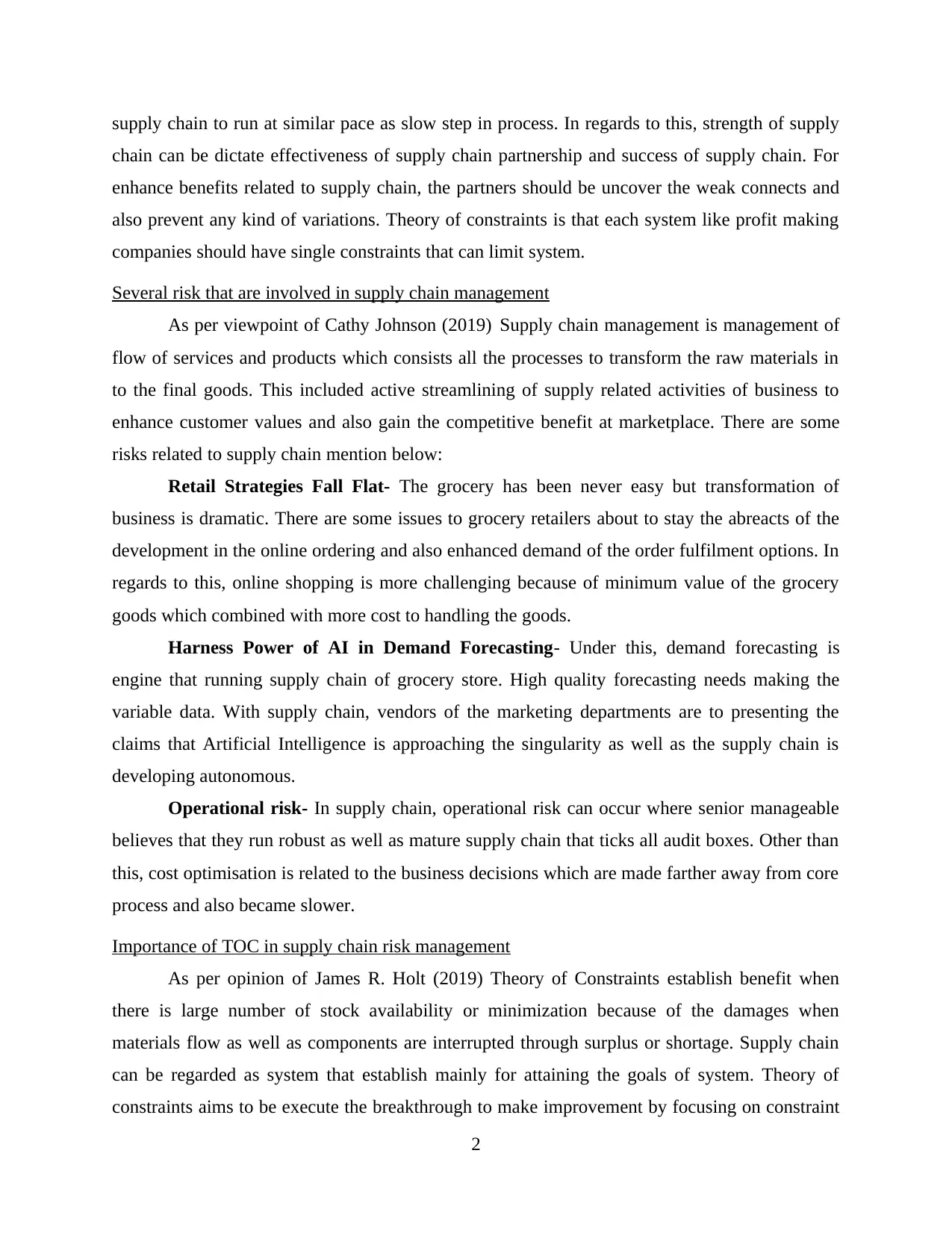
supply chain to run at similar pace as slow step in process. In regards to this, strength of supply
chain can be dictate effectiveness of supply chain partnership and success of supply chain. For
enhance benefits related to supply chain, the partners should be uncover the weak connects and
also prevent any kind of variations. Theory of constraints is that each system like profit making
companies should have single constraints that can limit system.
Several risk that are involved in supply chain management
As per viewpoint of Cathy Johnson (2019) Supply chain management is management of
flow of services and products which consists all the processes to transform the raw materials in
to the final goods. This included active streamlining of supply related activities of business to
enhance customer values and also gain the competitive benefit at marketplace. There are some
risks related to supply chain mention below:
Retail Strategies Fall Flat- The grocery has been never easy but transformation of
business is dramatic. There are some issues to grocery retailers about to stay the abreacts of the
development in the online ordering and also enhanced demand of the order fulfilment options. In
regards to this, online shopping is more challenging because of minimum value of the grocery
goods which combined with more cost to handling the goods.
Harness Power of AI in Demand Forecasting- Under this, demand forecasting is
engine that running supply chain of grocery store. High quality forecasting needs making the
variable data. With supply chain, vendors of the marketing departments are to presenting the
claims that Artificial Intelligence is approaching the singularity as well as the supply chain is
developing autonomous.
Operational risk- In supply chain, operational risk can occur where senior manageable
believes that they run robust as well as mature supply chain that ticks all audit boxes. Other than
this, cost optimisation is related to the business decisions which are made farther away from core
process and also became slower.
Importance of TOC in supply chain risk management
As per opinion of James R. Holt (2019) Theory of Constraints establish benefit when
there is large number of stock availability or minimization because of the damages when
materials flow as well as components are interrupted through surplus or shortage. Supply chain
can be regarded as system that establish mainly for attaining the goals of system. Theory of
constraints aims to be execute the breakthrough to make improvement by focusing on constraint
2
chain can be dictate effectiveness of supply chain partnership and success of supply chain. For
enhance benefits related to supply chain, the partners should be uncover the weak connects and
also prevent any kind of variations. Theory of constraints is that each system like profit making
companies should have single constraints that can limit system.
Several risk that are involved in supply chain management
As per viewpoint of Cathy Johnson (2019) Supply chain management is management of
flow of services and products which consists all the processes to transform the raw materials in
to the final goods. This included active streamlining of supply related activities of business to
enhance customer values and also gain the competitive benefit at marketplace. There are some
risks related to supply chain mention below:
Retail Strategies Fall Flat- The grocery has been never easy but transformation of
business is dramatic. There are some issues to grocery retailers about to stay the abreacts of the
development in the online ordering and also enhanced demand of the order fulfilment options. In
regards to this, online shopping is more challenging because of minimum value of the grocery
goods which combined with more cost to handling the goods.
Harness Power of AI in Demand Forecasting- Under this, demand forecasting is
engine that running supply chain of grocery store. High quality forecasting needs making the
variable data. With supply chain, vendors of the marketing departments are to presenting the
claims that Artificial Intelligence is approaching the singularity as well as the supply chain is
developing autonomous.
Operational risk- In supply chain, operational risk can occur where senior manageable
believes that they run robust as well as mature supply chain that ticks all audit boxes. Other than
this, cost optimisation is related to the business decisions which are made farther away from core
process and also became slower.
Importance of TOC in supply chain risk management
As per opinion of James R. Holt (2019) Theory of Constraints establish benefit when
there is large number of stock availability or minimization because of the damages when
materials flow as well as components are interrupted through surplus or shortage. Supply chain
can be regarded as system that establish mainly for attaining the goals of system. Theory of
constraints aims to be execute the breakthrough to make improvement by focusing on constraint
2
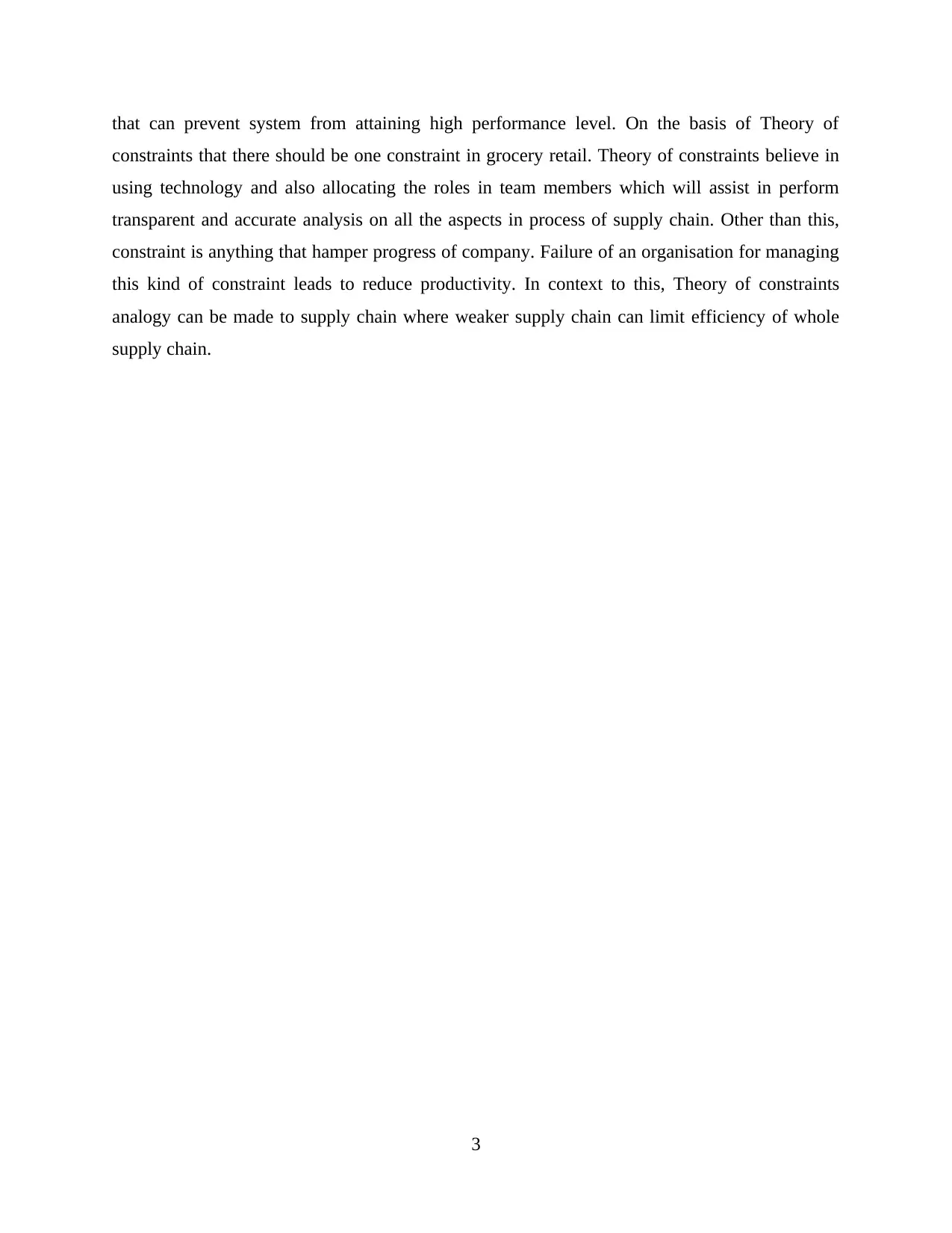
that can prevent system from attaining high performance level. On the basis of Theory of
constraints that there should be one constraint in grocery retail. Theory of constraints believe in
using technology and also allocating the roles in team members which will assist in perform
transparent and accurate analysis on all the aspects in process of supply chain. Other than this,
constraint is anything that hamper progress of company. Failure of an organisation for managing
this kind of constraint leads to reduce productivity. In context to this, Theory of constraints
analogy can be made to supply chain where weaker supply chain can limit efficiency of whole
supply chain.
3
constraints that there should be one constraint in grocery retail. Theory of constraints believe in
using technology and also allocating the roles in team members which will assist in perform
transparent and accurate analysis on all the aspects in process of supply chain. Other than this,
constraint is anything that hamper progress of company. Failure of an organisation for managing
this kind of constraint leads to reduce productivity. In context to this, Theory of constraints
analogy can be made to supply chain where weaker supply chain can limit efficiency of whole
supply chain.
3
⊘ This is a preview!⊘
Do you want full access?
Subscribe today to unlock all pages.

Trusted by 1+ million students worldwide
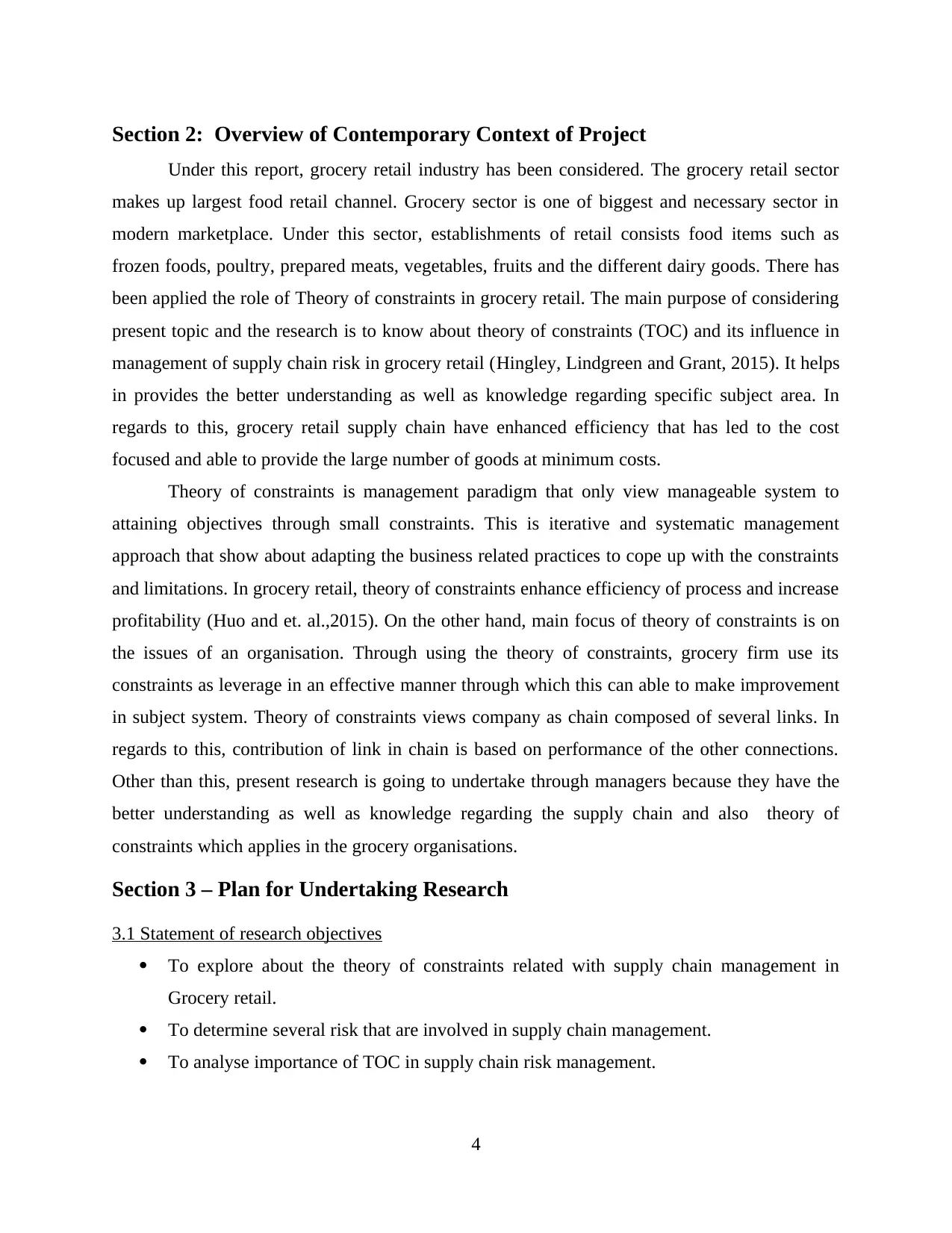
Section 2: Overview of Contemporary Context of Project
Under this report, grocery retail industry has been considered. The grocery retail sector
makes up largest food retail channel. Grocery sector is one of biggest and necessary sector in
modern marketplace. Under this sector, establishments of retail consists food items such as
frozen foods, poultry, prepared meats, vegetables, fruits and the different dairy goods. There has
been applied the role of Theory of constraints in grocery retail. The main purpose of considering
present topic and the research is to know about theory of constraints (TOC) and its influence in
management of supply chain risk in grocery retail (Hingley, Lindgreen and Grant, 2015). It helps
in provides the better understanding as well as knowledge regarding specific subject area. In
regards to this, grocery retail supply chain have enhanced efficiency that has led to the cost
focused and able to provide the large number of goods at minimum costs.
Theory of constraints is management paradigm that only view manageable system to
attaining objectives through small constraints. This is iterative and systematic management
approach that show about adapting the business related practices to cope up with the constraints
and limitations. In grocery retail, theory of constraints enhance efficiency of process and increase
profitability (Huo and et. al.,2015). On the other hand, main focus of theory of constraints is on
the issues of an organisation. Through using the theory of constraints, grocery firm use its
constraints as leverage in an effective manner through which this can able to make improvement
in subject system. Theory of constraints views company as chain composed of several links. In
regards to this, contribution of link in chain is based on performance of the other connections.
Other than this, present research is going to undertake through managers because they have the
better understanding as well as knowledge regarding the supply chain and also theory of
constraints which applies in the grocery organisations.
Section 3 – Plan for Undertaking Research
3.1 Statement of research objectives
To explore about the theory of constraints related with supply chain management in
Grocery retail.
To determine several risk that are involved in supply chain management.
To analyse importance of TOC in supply chain risk management.
4
Under this report, grocery retail industry has been considered. The grocery retail sector
makes up largest food retail channel. Grocery sector is one of biggest and necessary sector in
modern marketplace. Under this sector, establishments of retail consists food items such as
frozen foods, poultry, prepared meats, vegetables, fruits and the different dairy goods. There has
been applied the role of Theory of constraints in grocery retail. The main purpose of considering
present topic and the research is to know about theory of constraints (TOC) and its influence in
management of supply chain risk in grocery retail (Hingley, Lindgreen and Grant, 2015). It helps
in provides the better understanding as well as knowledge regarding specific subject area. In
regards to this, grocery retail supply chain have enhanced efficiency that has led to the cost
focused and able to provide the large number of goods at minimum costs.
Theory of constraints is management paradigm that only view manageable system to
attaining objectives through small constraints. This is iterative and systematic management
approach that show about adapting the business related practices to cope up with the constraints
and limitations. In grocery retail, theory of constraints enhance efficiency of process and increase
profitability (Huo and et. al.,2015). On the other hand, main focus of theory of constraints is on
the issues of an organisation. Through using the theory of constraints, grocery firm use its
constraints as leverage in an effective manner through which this can able to make improvement
in subject system. Theory of constraints views company as chain composed of several links. In
regards to this, contribution of link in chain is based on performance of the other connections.
Other than this, present research is going to undertake through managers because they have the
better understanding as well as knowledge regarding the supply chain and also theory of
constraints which applies in the grocery organisations.
Section 3 – Plan for Undertaking Research
3.1 Statement of research objectives
To explore about the theory of constraints related with supply chain management in
Grocery retail.
To determine several risk that are involved in supply chain management.
To analyse importance of TOC in supply chain risk management.
4
Paraphrase This Document
Need a fresh take? Get an instant paraphrase of this document with our AI Paraphraser
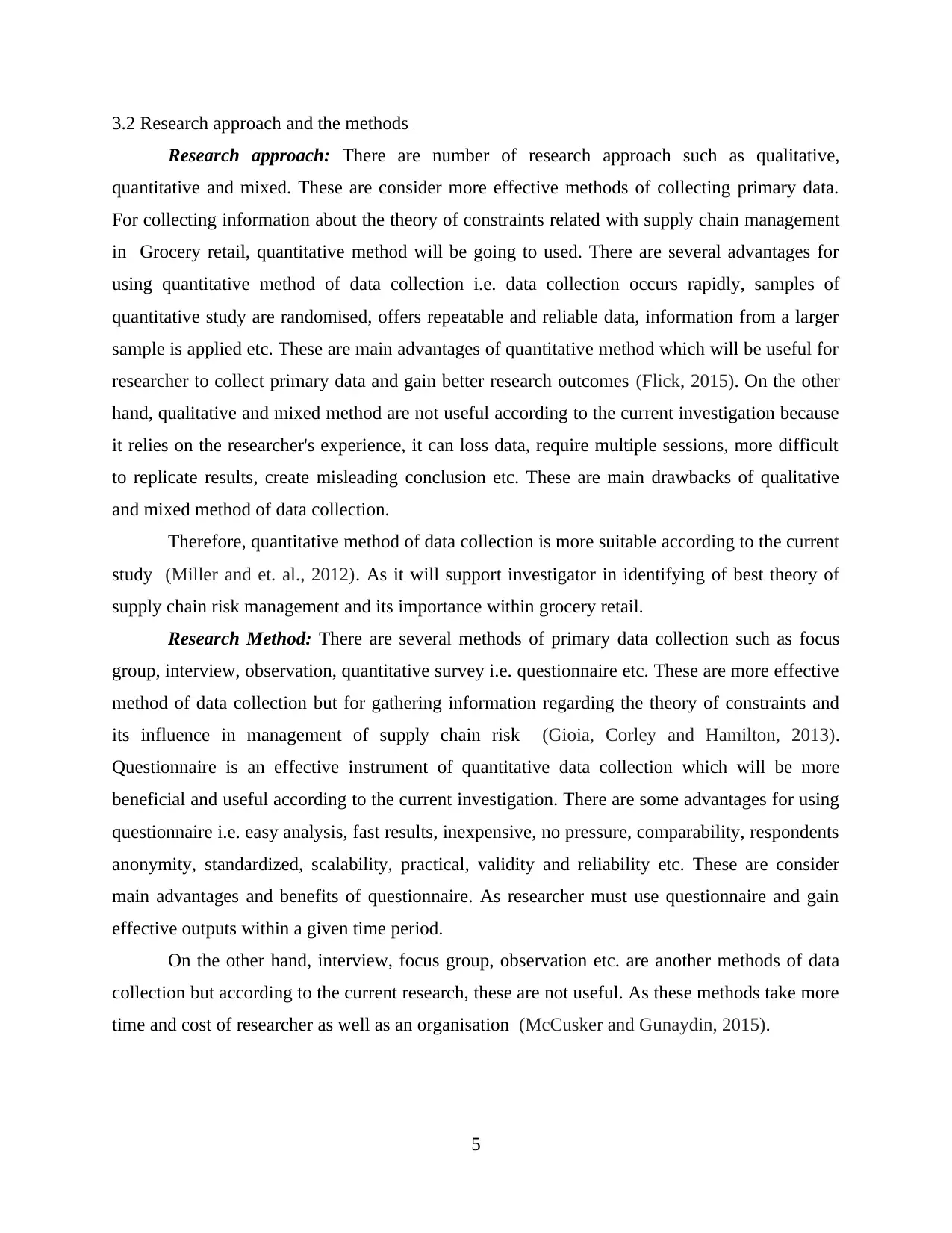
3.2 Research approach and the methods
Research approach: There are number of research approach such as qualitative,
quantitative and mixed. These are consider more effective methods of collecting primary data.
For collecting information about the theory of constraints related with supply chain management
in Grocery retail, quantitative method will be going to used. There are several advantages for
using quantitative method of data collection i.e. data collection occurs rapidly, samples of
quantitative study are randomised, offers repeatable and reliable data, information from a larger
sample is applied etc. These are main advantages of quantitative method which will be useful for
researcher to collect primary data and gain better research outcomes (Flick, 2015). On the other
hand, qualitative and mixed method are not useful according to the current investigation because
it relies on the researcher's experience, it can loss data, require multiple sessions, more difficult
to replicate results, create misleading conclusion etc. These are main drawbacks of qualitative
and mixed method of data collection.
Therefore, quantitative method of data collection is more suitable according to the current
study (Miller and et. al., 2012). As it will support investigator in identifying of best theory of
supply chain risk management and its importance within grocery retail.
Research Method: There are several methods of primary data collection such as focus
group, interview, observation, quantitative survey i.e. questionnaire etc. These are more effective
method of data collection but for gathering information regarding the theory of constraints and
its influence in management of supply chain risk (Gioia, Corley and Hamilton, 2013).
Questionnaire is an effective instrument of quantitative data collection which will be more
beneficial and useful according to the current investigation. There are some advantages for using
questionnaire i.e. easy analysis, fast results, inexpensive, no pressure, comparability, respondents
anonymity, standardized, scalability, practical, validity and reliability etc. These are consider
main advantages and benefits of questionnaire. As researcher must use questionnaire and gain
effective outputs within a given time period.
On the other hand, interview, focus group, observation etc. are another methods of data
collection but according to the current research, these are not useful. As these methods take more
time and cost of researcher as well as an organisation (McCusker and Gunaydin, 2015).
5
Research approach: There are number of research approach such as qualitative,
quantitative and mixed. These are consider more effective methods of collecting primary data.
For collecting information about the theory of constraints related with supply chain management
in Grocery retail, quantitative method will be going to used. There are several advantages for
using quantitative method of data collection i.e. data collection occurs rapidly, samples of
quantitative study are randomised, offers repeatable and reliable data, information from a larger
sample is applied etc. These are main advantages of quantitative method which will be useful for
researcher to collect primary data and gain better research outcomes (Flick, 2015). On the other
hand, qualitative and mixed method are not useful according to the current investigation because
it relies on the researcher's experience, it can loss data, require multiple sessions, more difficult
to replicate results, create misleading conclusion etc. These are main drawbacks of qualitative
and mixed method of data collection.
Therefore, quantitative method of data collection is more suitable according to the current
study (Miller and et. al., 2012). As it will support investigator in identifying of best theory of
supply chain risk management and its importance within grocery retail.
Research Method: There are several methods of primary data collection such as focus
group, interview, observation, quantitative survey i.e. questionnaire etc. These are more effective
method of data collection but for gathering information regarding the theory of constraints and
its influence in management of supply chain risk (Gioia, Corley and Hamilton, 2013).
Questionnaire is an effective instrument of quantitative data collection which will be more
beneficial and useful according to the current investigation. There are some advantages for using
questionnaire i.e. easy analysis, fast results, inexpensive, no pressure, comparability, respondents
anonymity, standardized, scalability, practical, validity and reliability etc. These are consider
main advantages and benefits of questionnaire. As researcher must use questionnaire and gain
effective outputs within a given time period.
On the other hand, interview, focus group, observation etc. are another methods of data
collection but according to the current research, these are not useful. As these methods take more
time and cost of researcher as well as an organisation (McCusker and Gunaydin, 2015).
5
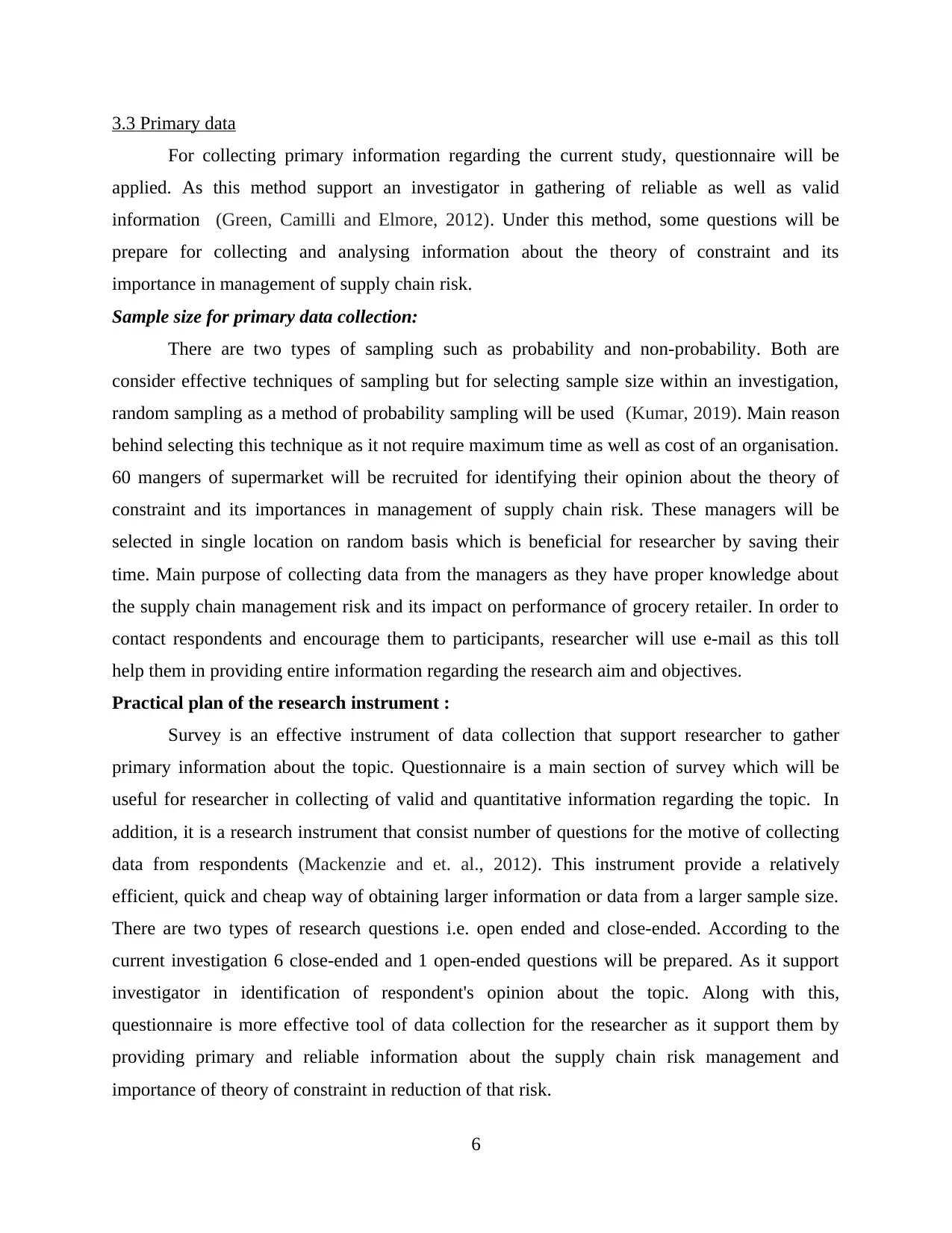
3.3 Primary data
For collecting primary information regarding the current study, questionnaire will be
applied. As this method support an investigator in gathering of reliable as well as valid
information (Green, Camilli and Elmore, 2012). Under this method, some questions will be
prepare for collecting and analysing information about the theory of constraint and its
importance in management of supply chain risk.
Sample size for primary data collection:
There are two types of sampling such as probability and non-probability. Both are
consider effective techniques of sampling but for selecting sample size within an investigation,
random sampling as a method of probability sampling will be used (Kumar, 2019). Main reason
behind selecting this technique as it not require maximum time as well as cost of an organisation.
60 mangers of supermarket will be recruited for identifying their opinion about the theory of
constraint and its importances in management of supply chain risk. These managers will be
selected in single location on random basis which is beneficial for researcher by saving their
time. Main purpose of collecting data from the managers as they have proper knowledge about
the supply chain management risk and its impact on performance of grocery retailer. In order to
contact respondents and encourage them to participants, researcher will use e-mail as this toll
help them in providing entire information regarding the research aim and objectives.
Practical plan of the research instrument :
Survey is an effective instrument of data collection that support researcher to gather
primary information about the topic. Questionnaire is a main section of survey which will be
useful for researcher in collecting of valid and quantitative information regarding the topic. In
addition, it is a research instrument that consist number of questions for the motive of collecting
data from respondents (Mackenzie and et. al., 2012). This instrument provide a relatively
efficient, quick and cheap way of obtaining larger information or data from a larger sample size.
There are two types of research questions i.e. open ended and close-ended. According to the
current investigation 6 close-ended and 1 open-ended questions will be prepared. As it support
investigator in identification of respondent's opinion about the topic. Along with this,
questionnaire is more effective tool of data collection for the researcher as it support them by
providing primary and reliable information about the supply chain risk management and
importance of theory of constraint in reduction of that risk.
6
For collecting primary information regarding the current study, questionnaire will be
applied. As this method support an investigator in gathering of reliable as well as valid
information (Green, Camilli and Elmore, 2012). Under this method, some questions will be
prepare for collecting and analysing information about the theory of constraint and its
importance in management of supply chain risk.
Sample size for primary data collection:
There are two types of sampling such as probability and non-probability. Both are
consider effective techniques of sampling but for selecting sample size within an investigation,
random sampling as a method of probability sampling will be used (Kumar, 2019). Main reason
behind selecting this technique as it not require maximum time as well as cost of an organisation.
60 mangers of supermarket will be recruited for identifying their opinion about the theory of
constraint and its importances in management of supply chain risk. These managers will be
selected in single location on random basis which is beneficial for researcher by saving their
time. Main purpose of collecting data from the managers as they have proper knowledge about
the supply chain management risk and its impact on performance of grocery retailer. In order to
contact respondents and encourage them to participants, researcher will use e-mail as this toll
help them in providing entire information regarding the research aim and objectives.
Practical plan of the research instrument :
Survey is an effective instrument of data collection that support researcher to gather
primary information about the topic. Questionnaire is a main section of survey which will be
useful for researcher in collecting of valid and quantitative information regarding the topic. In
addition, it is a research instrument that consist number of questions for the motive of collecting
data from respondents (Mackenzie and et. al., 2012). This instrument provide a relatively
efficient, quick and cheap way of obtaining larger information or data from a larger sample size.
There are two types of research questions i.e. open ended and close-ended. According to the
current investigation 6 close-ended and 1 open-ended questions will be prepared. As it support
investigator in identification of respondent's opinion about the topic. Along with this,
questionnaire is more effective tool of data collection for the researcher as it support them by
providing primary and reliable information about the supply chain risk management and
importance of theory of constraint in reduction of that risk.
6
⊘ This is a preview!⊘
Do you want full access?
Subscribe today to unlock all pages.

Trusted by 1+ million students worldwide
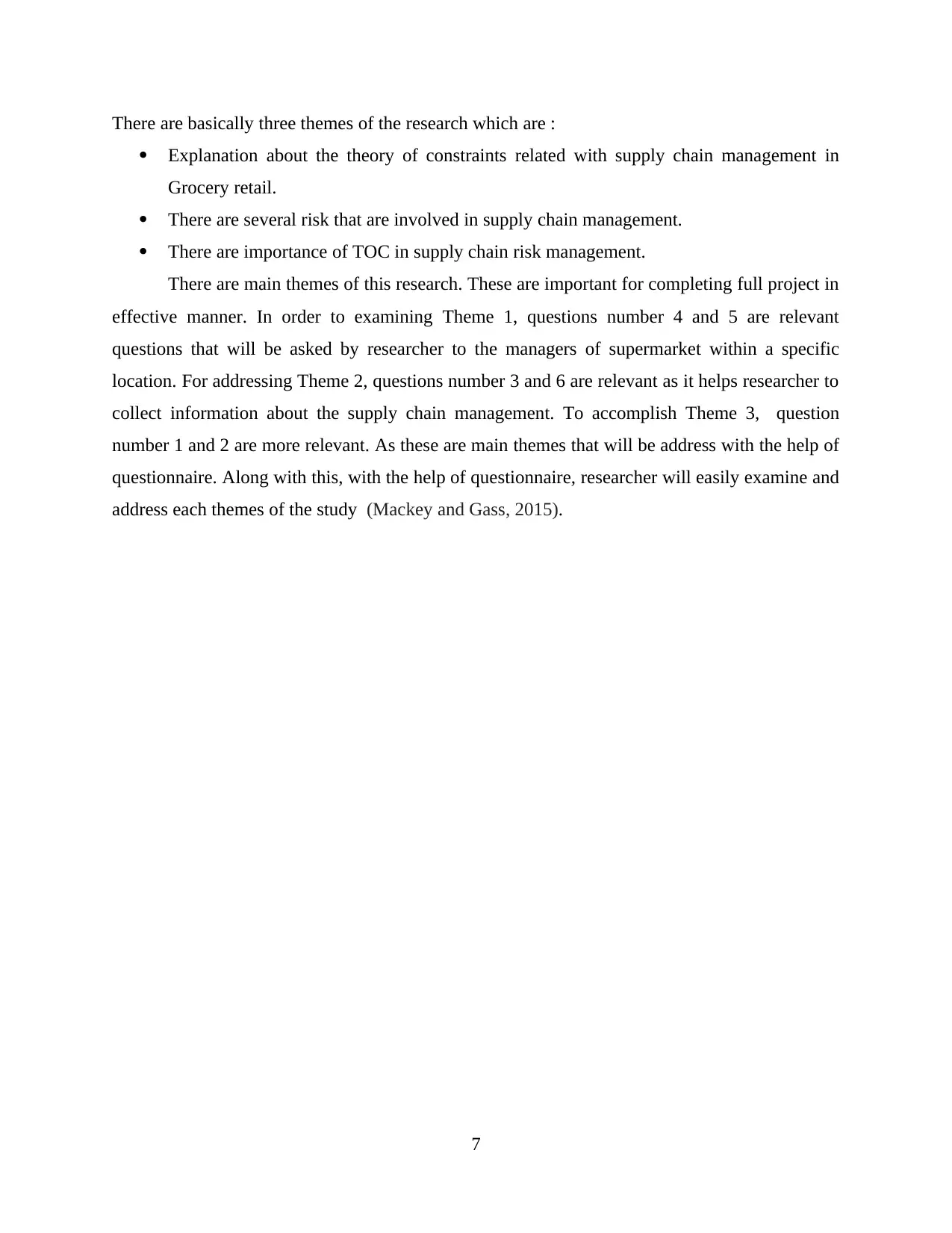
There are basically three themes of the research which are :
Explanation about the theory of constraints related with supply chain management in
Grocery retail.
There are several risk that are involved in supply chain management.
There are importance of TOC in supply chain risk management.
There are main themes of this research. These are important for completing full project in
effective manner. In order to examining Theme 1, questions number 4 and 5 are relevant
questions that will be asked by researcher to the managers of supermarket within a specific
location. For addressing Theme 2, questions number 3 and 6 are relevant as it helps researcher to
collect information about the supply chain management. To accomplish Theme 3, question
number 1 and 2 are more relevant. As these are main themes that will be address with the help of
questionnaire. Along with this, with the help of questionnaire, researcher will easily examine and
address each themes of the study (Mackey and Gass, 2015).
7
Explanation about the theory of constraints related with supply chain management in
Grocery retail.
There are several risk that are involved in supply chain management.
There are importance of TOC in supply chain risk management.
There are main themes of this research. These are important for completing full project in
effective manner. In order to examining Theme 1, questions number 4 and 5 are relevant
questions that will be asked by researcher to the managers of supermarket within a specific
location. For addressing Theme 2, questions number 3 and 6 are relevant as it helps researcher to
collect information about the supply chain management. To accomplish Theme 3, question
number 1 and 2 are more relevant. As these are main themes that will be address with the help of
questionnaire. Along with this, with the help of questionnaire, researcher will easily examine and
address each themes of the study (Mackey and Gass, 2015).
7
Paraphrase This Document
Need a fresh take? Get an instant paraphrase of this document with our AI Paraphraser
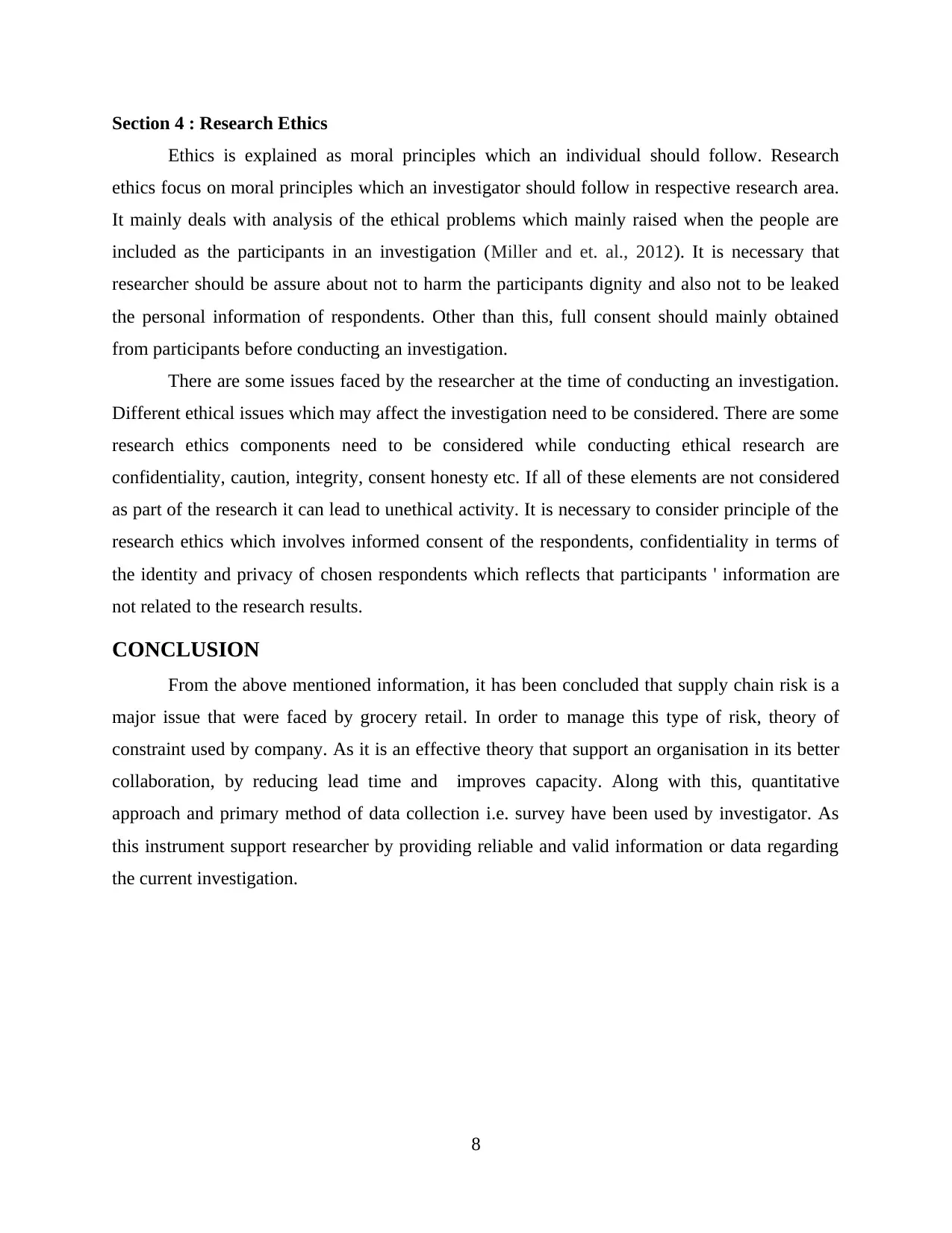
Section 4 : Research Ethics
Ethics is explained as moral principles which an individual should follow. Research
ethics focus on moral principles which an investigator should follow in respective research area.
It mainly deals with analysis of the ethical problems which mainly raised when the people are
included as the participants in an investigation (Miller and et. al., 2012). It is necessary that
researcher should be assure about not to harm the participants dignity and also not to be leaked
the personal information of respondents. Other than this, full consent should mainly obtained
from participants before conducting an investigation.
There are some issues faced by the researcher at the time of conducting an investigation.
Different ethical issues which may affect the investigation need to be considered. There are some
research ethics components need to be considered while conducting ethical research are
confidentiality, caution, integrity, consent honesty etc. If all of these elements are not considered
as part of the research it can lead to unethical activity. It is necessary to consider principle of the
research ethics which involves informed consent of the respondents, confidentiality in terms of
the identity and privacy of chosen respondents which reflects that participants ' information are
not related to the research results.
CONCLUSION
From the above mentioned information, it has been concluded that supply chain risk is a
major issue that were faced by grocery retail. In order to manage this type of risk, theory of
constraint used by company. As it is an effective theory that support an organisation in its better
collaboration, by reducing lead time and improves capacity. Along with this, quantitative
approach and primary method of data collection i.e. survey have been used by investigator. As
this instrument support researcher by providing reliable and valid information or data regarding
the current investigation.
8
Ethics is explained as moral principles which an individual should follow. Research
ethics focus on moral principles which an investigator should follow in respective research area.
It mainly deals with analysis of the ethical problems which mainly raised when the people are
included as the participants in an investigation (Miller and et. al., 2012). It is necessary that
researcher should be assure about not to harm the participants dignity and also not to be leaked
the personal information of respondents. Other than this, full consent should mainly obtained
from participants before conducting an investigation.
There are some issues faced by the researcher at the time of conducting an investigation.
Different ethical issues which may affect the investigation need to be considered. There are some
research ethics components need to be considered while conducting ethical research are
confidentiality, caution, integrity, consent honesty etc. If all of these elements are not considered
as part of the research it can lead to unethical activity. It is necessary to consider principle of the
research ethics which involves informed consent of the respondents, confidentiality in terms of
the identity and privacy of chosen respondents which reflects that participants ' information are
not related to the research results.
CONCLUSION
From the above mentioned information, it has been concluded that supply chain risk is a
major issue that were faced by grocery retail. In order to manage this type of risk, theory of
constraint used by company. As it is an effective theory that support an organisation in its better
collaboration, by reducing lead time and improves capacity. Along with this, quantitative
approach and primary method of data collection i.e. survey have been used by investigator. As
this instrument support researcher by providing reliable and valid information or data regarding
the current investigation.
8
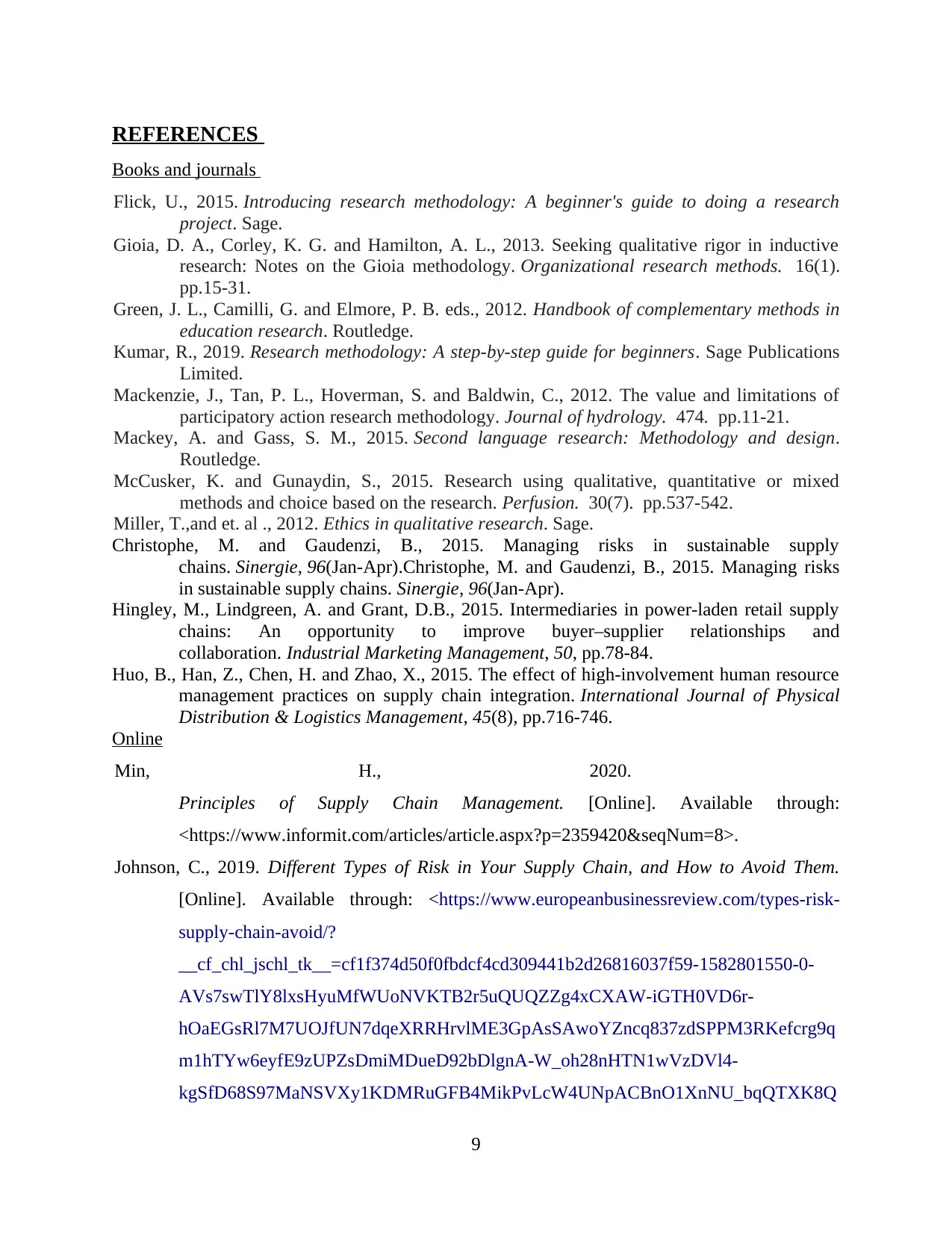
REFERENCES
Books and journals
Flick, U., 2015. Introducing research methodology: A beginner's guide to doing a research
project. Sage.
Gioia, D. A., Corley, K. G. and Hamilton, A. L., 2013. Seeking qualitative rigor in inductive
research: Notes on the Gioia methodology. Organizational research methods. 16(1).
pp.15-31.
Green, J. L., Camilli, G. and Elmore, P. B. eds., 2012. Handbook of complementary methods in
education research. Routledge.
Kumar, R., 2019. Research methodology: A step-by-step guide for beginners. Sage Publications
Limited.
Mackenzie, J., Tan, P. L., Hoverman, S. and Baldwin, C., 2012. The value and limitations of
participatory action research methodology. Journal of hydrology. 474. pp.11-21.
Mackey, A. and Gass, S. M., 2015. Second language research: Methodology and design.
Routledge.
McCusker, K. and Gunaydin, S., 2015. Research using qualitative, quantitative or mixed
methods and choice based on the research. Perfusion. 30(7). pp.537-542.
Miller, T.,and et. al ., 2012. Ethics in qualitative research. Sage.
Christophe, M. and Gaudenzi, B., 2015. Managing risks in sustainable supply
chains. Sinergie, 96(Jan-Apr).Christophe, M. and Gaudenzi, B., 2015. Managing risks
in sustainable supply chains. Sinergie, 96(Jan-Apr).
Hingley, M., Lindgreen, A. and Grant, D.B., 2015. Intermediaries in power-laden retail supply
chains: An opportunity to improve buyer–supplier relationships and
collaboration. Industrial Marketing Management, 50, pp.78-84.
Huo, B., Han, Z., Chen, H. and Zhao, X., 2015. The effect of high-involvement human resource
management practices on supply chain integration. International Journal of Physical
Distribution & Logistics Management, 45(8), pp.716-746.
Online
Min, H., 2020.
Principles of Supply Chain Management. [Online]. Available through:
<https://www.informit.com/articles/article.aspx?p=2359420&seqNum=8>.
Johnson, C., 2019. Different Types of Risk in Your Supply Chain, and How to Avoid Them.
[Online]. Available through: <https://www.europeanbusinessreview.com/types-risk-
supply-chain-avoid/?
__cf_chl_jschl_tk__=cf1f374d50f0fbdcf4cd309441b2d26816037f59-1582801550-0-
AVs7swTlY8lxsHyuMfWUoNVKTB2r5uQUQZZg4xCXAW-iGTH0VD6r-
hOaEGsRl7M7UOJfUN7dqeXRRHrvlME3GpAsSAwoYZncq837zdSPPM3RKefcrg9q
m1hTYw6eyfE9zUPZsDmiMDueD92bDlgnA-W_oh28nHTN1wVzDVl4-
kgSfD68S97MaNSVXy1KDMRuGFB4MikPvLcW4UNpACBnO1XnNU_bqQTXK8Q
9
Books and journals
Flick, U., 2015. Introducing research methodology: A beginner's guide to doing a research
project. Sage.
Gioia, D. A., Corley, K. G. and Hamilton, A. L., 2013. Seeking qualitative rigor in inductive
research: Notes on the Gioia methodology. Organizational research methods. 16(1).
pp.15-31.
Green, J. L., Camilli, G. and Elmore, P. B. eds., 2012. Handbook of complementary methods in
education research. Routledge.
Kumar, R., 2019. Research methodology: A step-by-step guide for beginners. Sage Publications
Limited.
Mackenzie, J., Tan, P. L., Hoverman, S. and Baldwin, C., 2012. The value and limitations of
participatory action research methodology. Journal of hydrology. 474. pp.11-21.
Mackey, A. and Gass, S. M., 2015. Second language research: Methodology and design.
Routledge.
McCusker, K. and Gunaydin, S., 2015. Research using qualitative, quantitative or mixed
methods and choice based on the research. Perfusion. 30(7). pp.537-542.
Miller, T.,and et. al ., 2012. Ethics in qualitative research. Sage.
Christophe, M. and Gaudenzi, B., 2015. Managing risks in sustainable supply
chains. Sinergie, 96(Jan-Apr).Christophe, M. and Gaudenzi, B., 2015. Managing risks
in sustainable supply chains. Sinergie, 96(Jan-Apr).
Hingley, M., Lindgreen, A. and Grant, D.B., 2015. Intermediaries in power-laden retail supply
chains: An opportunity to improve buyer–supplier relationships and
collaboration. Industrial Marketing Management, 50, pp.78-84.
Huo, B., Han, Z., Chen, H. and Zhao, X., 2015. The effect of high-involvement human resource
management practices on supply chain integration. International Journal of Physical
Distribution & Logistics Management, 45(8), pp.716-746.
Online
Min, H., 2020.
Principles of Supply Chain Management. [Online]. Available through:
<https://www.informit.com/articles/article.aspx?p=2359420&seqNum=8>.
Johnson, C., 2019. Different Types of Risk in Your Supply Chain, and How to Avoid Them.
[Online]. Available through: <https://www.europeanbusinessreview.com/types-risk-
supply-chain-avoid/?
__cf_chl_jschl_tk__=cf1f374d50f0fbdcf4cd309441b2d26816037f59-1582801550-0-
AVs7swTlY8lxsHyuMfWUoNVKTB2r5uQUQZZg4xCXAW-iGTH0VD6r-
hOaEGsRl7M7UOJfUN7dqeXRRHrvlME3GpAsSAwoYZncq837zdSPPM3RKefcrg9q
m1hTYw6eyfE9zUPZsDmiMDueD92bDlgnA-W_oh28nHTN1wVzDVl4-
kgSfD68S97MaNSVXy1KDMRuGFB4MikPvLcW4UNpACBnO1XnNU_bqQTXK8Q
9
⊘ This is a preview!⊘
Do you want full access?
Subscribe today to unlock all pages.

Trusted by 1+ million students worldwide
1 out of 13
Related Documents
Your All-in-One AI-Powered Toolkit for Academic Success.
+13062052269
info@desklib.com
Available 24*7 on WhatsApp / Email
![[object Object]](/_next/static/media/star-bottom.7253800d.svg)
Unlock your academic potential
Copyright © 2020–2025 A2Z Services. All Rights Reserved. Developed and managed by ZUCOL.





